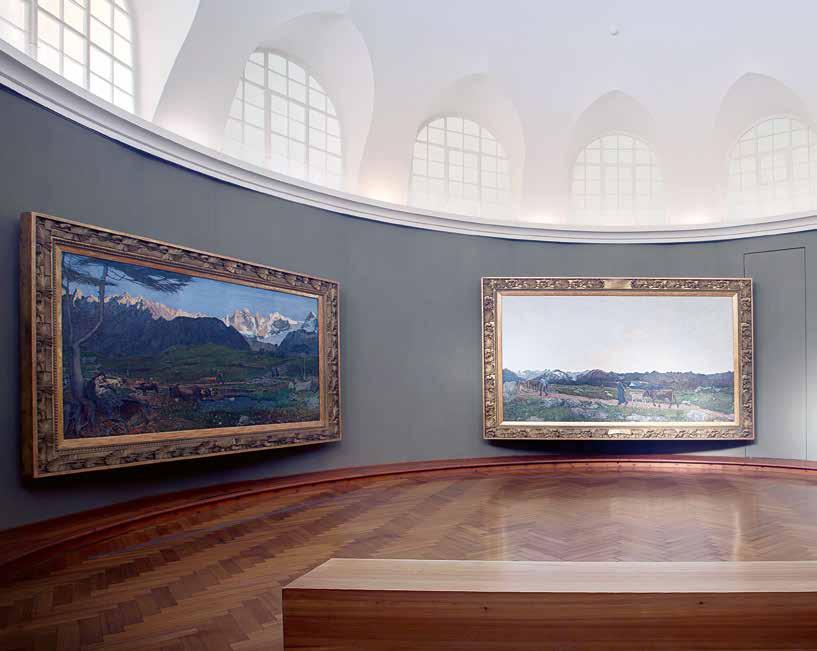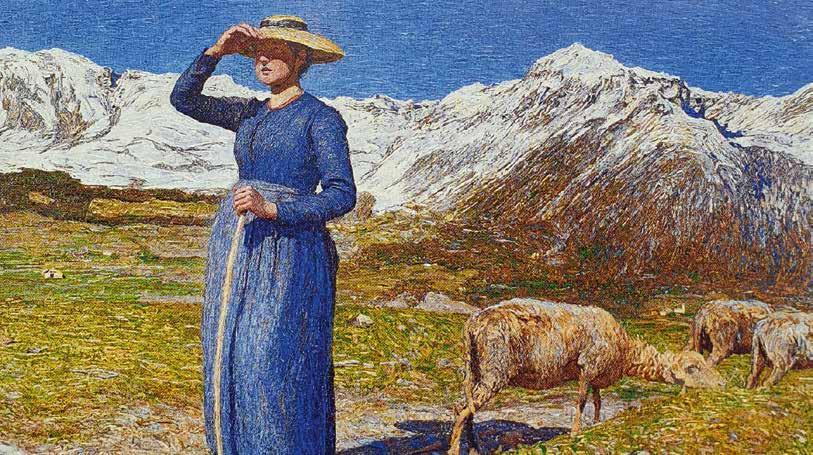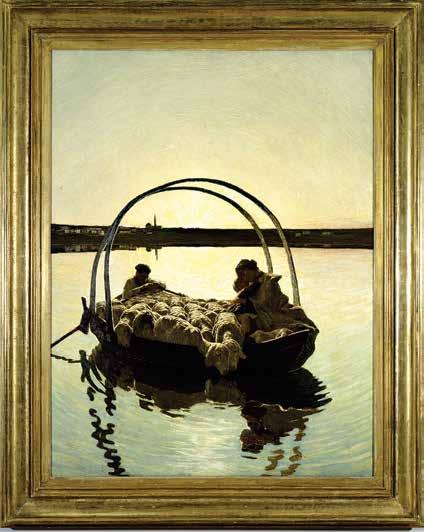
8 minute read
Auf den Spuren von Giovanni Segantini
from Glacier Express 2021
by MetroComm AG
FOLLOWING THE TRACKS OF GIOVANNI SEGANTINI
Dr. Mirella Carbone, Künstlerische Leiterin des Segantini-Museums in St.Moritz, stellt das eindrückliche Leben und Wirken von Giovanni Segantini vor.
Mirella Carbone, nach Lebensstationen in Mailand, Brianza, Savognin und Maloja starb der berühmte Maler am 28. September 1899 überraschend an einer Bauchfellentzündung auf dem Schafberg, wo er am «Alpentriptychon» arbeiten wollte. Dieses wichtige Werk ist im Segantini-Museum zu finden. St.Moritz hat Giovanni Segantini mit diesem Museum ein würdevolles Denkmal gesetzt. Wie kam es dazu?
Das Segantini-Museum entstand 1908 auf Initiative von Freunden und Verehrern des Künstlers. Sie gaben dem Architekten Nicolaus Hartmann den Auftrag, einen Bau zu errichten, der gleichzeitig Mausoleum, also begehbares Denkmal für den Künstler, und Ausstellungsraum für dessen Hauptwerk, das «Alpentriptychon», sein sollte. Die Hauptachse des Museums ist Richtung Schafberg gerichtet, damit eine ideale Verbindungslinie zwischen dem Sterbeort des Künstlers und diesem Denkmal entstehe. Heute besteht unser Team aus sechs Personen in Teilzeitpensum.
Als künstlerische Leiterin des Segantini-Museums haben Sie sich schon lange mit dem Menschen und den Werken Segantinis auseinandergesetzt. Wie fanden Sie zu ihm und seinem Schaffen?
Bereits als Kind hat mich die Kopie von Segantinis «Ave Maria bei der Überfahrt», die im Wohnzimmer meiner Grossmutter hing, berührt und beglückt. Aber erst seit ich mich beruflich mit ihm beschäftige, ist mir bewusst geworden, dass diese anscheinend unmittelbare, realistische Darstellung des Bauernalltags in Wirklichkeit ein in allen Details durchkomponiertes Kunstgebilde ist, in dem jedes Element eine oder sogar mehrere symbolische Bedeutungen hat. Segantini ist kein spontaner Landschaftsmaler und Darsteller der Bauernwelt, sondern ein sehr reflektierter, ein «philosophischer» Künstler.
Was ist das Besondere an Giovanni Segantini und seiner Kunst?
Einmalig ist sein Talent, das Licht wiederzugeben: Der junge Segantini ermöglicht uns Betrachtenden das Erleben besonderer Lichteffekte durch überbetonte Hell-Dunkel-Kontraste, der reife Maler erreicht das gleiche Ziel durch die Anwendung der reinen Farbe und der divisionistischen Technik. Besonders an seiner reifen Kunst ist ferner die Verschmelzung von Realismus und Symbolismus, die seinen Werken Mehrdimensionalität und Tiefe geben.
Das Triptychon «Werden – Sein – Vergehen» ist die grosse Attraktion im Segantini Museum. Bild: Filip Zuan «We should recognize that portraits are the most demanding works, artistically and creatively» – Giovanni Segantini.
AUF DEN SPUREN VON GIOVANNI SEGANTINI
FOLLOWING THE TRACKS OF GIOVANNI SEGANTINI

Allein schon mit seinem Alpentriptychon, dem dreiteiligen Gemälde «Werden – Sein – Vergehen», schuf der eigentlich staatenlose Maler Giovanni Segantini (1858-1899) ein Kunstwerk mit Weltruf, das im gleichnamigen Museum in St.Moritz bestaunt werden kann.
The stateless painter Giovanni Segantini (1858-1899) achieved world renown with his Alpine Triptych, the three-part painting Life – Nature – Death, which can be admired in the museum in St.Moritz that bears his name.
Dr. Mirella Carbone, artistic director of the Segantini Museum in St.Moritz, talks about the impressive life and work of Giovanni Segantini.
Mirella Carbone, after living in Milan, Brianza, Savognin and Maloja, the famous painter died suddenly of peritonitis on 28 September 1899 on the Schafberg mountain, where he was working on the Alpine Triptych. This important work can be viewed in the Segantini Museum – a fitting monument to Giovanni Segantini erected by St.Moritz. How did it come into being?
The Segantini Museum was created in 1908 on the initiative of friends and admirers of the artist. They commissioned the architect Nicolaus Hartmann to construct a building that would be both a sort of mausoleum — in the sense of an accessible monument to the artist – and an exhibition space for his magnum opus, the Alpine Triptych. The central part of the building points towards the Schafberg, creating an ideal line connecting the place where the artist died and this monument. Today, our team consists of six people working part time.
As the artistic director of the Segantini Museum, you have long been interested in both Segantini’s oeuvre and the man himself. What drew you to him and his work?
Even as a young child, I was moved and delighted by the copy of Segantini’s Ave Maria on the Lake that hung in my grandmother's living room. But it was only once I became professionally involved that I realised that this seemingly unmediated, realistic depiction of the everyday life of shepherds is in reality a carefully composed artistic construct in every detail, in which each element has one or even several symbolical meanings. Far from being a spontaneous landscape painter and depicter of peasant life, Segantini is an extremely reflective, «philosophical» artist.
What’s special about Giovanni Segantini and his art?
He has a unique ability to render light and luminosity. The young Segantini enables the viewer to experience extraordinary lighting effects through his strong contrasts of light and shade; the mature artist achieves the same aim by using pure colour and the Divisionist technique. What is also special about his later art is the fusion of realism and symbolism, which gives his works multidimensionality and depth.

Eines der berühmtesten Bilder von Giovanni Segantini: «Mittag in den Alpen» aus dem Jahr 1891. Bild: Segantini-Museum One of the most famous paintings by Giovanni Segantini: Midday in the Alps, from 1891.
Welches sind die Highlights im Segantini-Museum?
Das absolute Highlight in unserem Museum ist das majestätische Triptychon «Werden – Sein – Vergehen», ein Meisterwerk divisionistischer Technik und gleichzeitig Segantinis geistiges Testament, in dem er seinem Credo in die zyklische Wiederkehr allen Lebens Ausdruck gibt.
Wie viele Besucher haben Sie pro Jahr?
Zwischen 25'000 und 30'000 Menschen aus der ganzen Welt besuchen jährlich das Museum. Segantini ist, abgesehen von der Schweiz, ganz besonders in Italien, Österreich und Japan sehr beliebt.
Wenn Sie heute Giovanni Segantini persönlich treffen könnten, welche Themen würden Sie gerne mit ihm besprechen?
Über seine Einstellung zum Tod und zum Göttlichen, denn in seinem Werk spielen diese beiden Themen eine zentrale Rolle. Die Haltung des Künstlers dazu ist aber nicht eindeutig belegt.
segantini-museum.ch segantinihuette.ch
Mirella Carbone
Mirella Carbone (*1967) ist in Catania (Sizilien) geboren und aufgewachsen, sie hat Germanistik und Kunstgeschichte studiert. Seit 30 Jahren lebt sie im Oberengadin, ist wissenschaftliche Mitarbeiterin am Institut für Kulturforschung Graubünden und seit Oktober 2016 künstlerische Leiterin des Segantini Museums in St.Moritz.
Mirella Carbone
Mirella Carbone (*1967) was born and grew up in Catania (Sicily), where she studied German and art history. For the past 30 years, she has lived in the Upper Engadine. She is a research assistant at the Institute for Cultural Research Graubünden and has been the artistic director of the Segantini Museum in St.Moritz since October 2016.
What are the highlights in the Segantini Museum?
The absolute highlight of our museum is the majestic triptych Life – Nature – Death, a masterpiece of Divisionist technique and at the same time Segantini's spiritual testament, in which he expresses his credo of the cyclical return of all life.
How many visitors do you receive a year?
Between 25,000 and 30,000 people from all over the world visit the museum each year. Apart from Switzerland, Segantini is particularly popular in Italy, Austria and Japan.
If you could meet Giovanni Segantini today, what would you like to talk to him about?
About his attitude towards death and the divine. These two themes play a central role in his work, and the artist’s position on them is not clear from the records we have.
segantini-museum.ch segantinihuette.ch
Eindrucksvolles Lichtspiel mit dem Segantini Werk «Ave Maria bei der Überfahrt». Bild: Segantini-Museum Impressive play of light in Segantini’s Ave Maria on the Lake.

Sonderausstellung 2021
Berühmt wurde Giovanni Segantini bereits zu Lebzeiten als Landschaftsmaler, ja als grosser Erneuerer der Alpenmalerei. Er selbst allerdings schätzte eine andere bildkünstlerische Gattung als die edelste ein, nämlich das Porträt, da es «das Erforschen des menschlichen Antlitzes zum Ziel hat». Bildnisse seien Studien, «die mit der grössten Einfachheit der Mittel das wirksamste Wort der Kunst im Ausdruck der lebendigen Form umfassen».
Obwohl viele Porträts aus Segantinis Hand immer wieder in Ausstellungen zu sehen waren, standen sie bislang nie im Zentrum einer expliziten Auseinandersetzung. Mit einer zwar kleinen, aber qualitativ hochstehenden Auswahl von Bildnissen und Selbstbildnissen aus öffentlichen und privaten Sammlungen möchte das Segantini-Museum diese Lücke schliessen. Gezeigt werden sehr intime Zeichnungen, wie jene seines dreijährigen Sohnes Gottardo nach einer Operation, sowie repräsentative Gemälde wie die Porträts der Geschwister Vittore und Leopoldina Grubicy, die zu den schönsten Beispielen von Segantinis Talent als «Erforscher des menschlichen Antlitzes» gehören. Die Sonderausstellung vom 2. Juni bis 20. Oktober 2021 wird kuratiert von Prof. Annie-Paule Quinsac und Dr. Mirella Carbone.
Special exhibition 2021
Giovanni Segantini became famous in his own lifetime as a landscape painter and more especially as a great innovator of Alpine painting. However, he himself considered another pictorial genre, that of portraiture, to be the noblest, as it «aims to explore the human face». In his view, portraits were studies «that, with the greatest simplicity of means, embrace the most effective word of art in the expression of living form».
Although many of Segantini’s portraits have been repeatedly shown in exhibitions, they have never been the focus of explicit attention until now. The Segantini Museum would like to fill this gap with a small but high-quality selection of portraits (and self-portraits) from public and private collections. The exhibition includes very intimate drawings, such as those of Segantini’s three-year-old son Gottardo after an operation, and formal portraits, such as the paintings of siblings Vittore and Leopoldina Grubicy, which are among the finest examples of his talent as an «explorer of the human face». The special exhibition, from 2 June to 20 October 2021, is curated by Annie-Paule Quinsac and Mirella Carbone.










